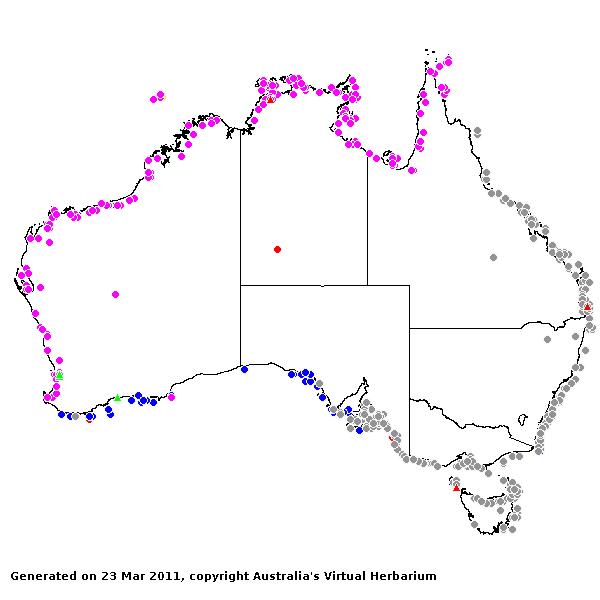Spinifex Mant. 163, 300 (1771).
Derivation:. From Latin spinofix (thorn maker), alluding to the sharp leaves of some species.
Taxonomic revisions, nomenclatural references:. G.F.Craig, Nuytsia 5: 67–74 (1984).
Key references (keys and floras):. G.Bentham, Flora Australiensis 7: 503–505 (1878) (incl. Zygochloa); C.A.Gardner, Flora of Western Australia 1 Gramineae 250–252 (1952); E.E.Henty, Manual Grasses New Guinea 177, 180 (1969); J.W.Vickery, Flora of New South Wales, Gramineae 19: 269–271 (1975); M.Lazarides, Tropical Grasses S.E. Asia 143–144 (1980); J.C.Tothill and J.B.Hacker, Grasses of Southern Queensland 384–385 (1983); J.P.Jessop, Flora of South Australia 4: 1978–1979 (1986); R.D.Webster, Australian Paniceae 216–219 (1987); Heyligers, A.S.B.S. Newsletter 56: 13–15 (1988); T.D.Macfarlane, Flora of the Kimberley Region 1222 (1992); B.K.Simon, Key to Australian Grasses 159–160 (1993); S.W.L.Jacobs and S.M.Hastings, Flora of New South Wales 4: 504(1993); N.G.Walsh, Flora Victoria 2: 615–616 (1994); D.I.Morris, Student's Flora of Tasmania 4B: 351–353 (1994); E.Edgar and H.E.Connor, Flora of New Zealand 5: 589–591 (2000); D.Sharp and B.K.Simon, AusGrass (2002); J.P.Jessop, Grasses of South Australia 486–488 (2006); S.W.L.Jacobs, R.D.B.Whalley & D.J.B.Wheeler, Grasses of New South Wales, 4th ed, 373–374 (2008).
W.D.Clayton & S.A.Renvoize, Genera Graminum (1986), genus (545).
Native. 5 species (including 1 hybrid), from eastern Asia, Indomalayan region, Pacific, Australia. 4 species in Australia, WA, NT, SA, Qld, NSW, Vic, and Tas. Also New Guinea, Malesia and New Zealand.
Habit. Perennial, rhizomatous and tufted. Leaf blades narrow, hard, woody, needle-like or not needle-like. Ligule a fringe of hairs. Plants dioecious.
Inflorescence. Inflorescence very peculiar, the female-fertile spikelets solitary at the bases of long, bare rachides, which are bristle-like and clustered in dense spatheate umbels: the latter fall entire and are blown about; male spikelets in rigid spikes clustered in spatheate umbels, of two types.
Spikelets. Spikelets dorsally compressed, 2 flowered, with 1 fertile floret, associated with bractiform involucres (consisting of spathes), solitary or several in a whorl, subsessile. Fertile spikelets with lower incomplete floret(s), elliptic or lanceolate or ovate, falling with glumes (female-fertile spikelets falling with the umbel, tardily disarticulating from their pedicels).
Glumes. Glumes more or less equal, long relative to adjacent lemmas, hairy or hairless, awnless, non-keeled, similar (acute, papery, entire). Lower glume 7–11 nerved. Upper glume 7–11 nerved.
Florets. Lower incomplete floret(s) sterile. Lemmas awnless, 5 nerved, exceeded by fertile lemmas to exceeding fertile lemmas, similar in texture to fertile lemmas, not becoming indurated. Fertile florets 1. Lemmas decidedly firmer than glumes (finally), smooth, becoming indurated to not becoming indurated, yellow in fruit, muticous, with a clear germination flap, 3–11 nerved, glabrous. Palea relatively long, textured like lemma, indurated, 2 nerved. Lodicules 2. Stamens 3 or 0 (then 3 staminodes). Grain medium sized, ellipsoid, compressed dorsiventrally. Hilum short. Embryo large.
Kranz Anatomy. C4, biochemical type NADP-ME (1 species).
2n = 18, 2 ploid.
Habitat. Xerophytic. Binding coastal sand dunes. Species of open habitats.
Classification. Panicoideae; Paniceae.
Notes. The male inflorescence is a raceme and terminates in a relatively short bristle. Spikelets are biseriate or occur in many rows. The female inflorescences are subtended by bracts and clustered to form a pseudo-head (Webster, 1987). Phylogenetically Spinifex is related to Zygochloa (Zuolaga, Morrone and Giussani, 2000), both being dioecious, and they are both sister to Xerochloa, which is not dioecious (B.K.Simon).
Types Species. S. squarrosus L.
Biogeographic Element. Clifford & Simon 1981, Simon & Jacobs 1990: Indo-Malayan.


